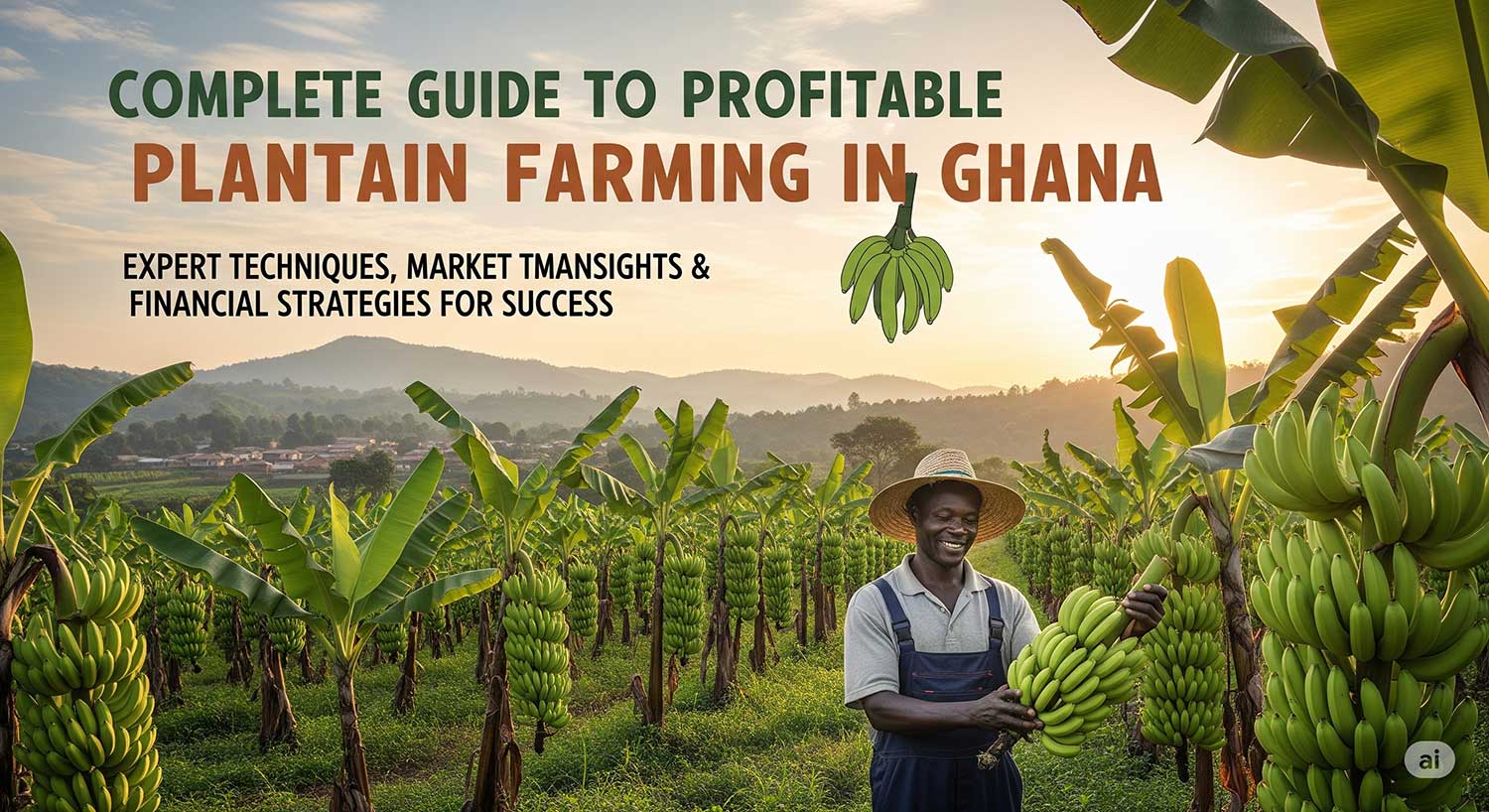Your Complete Guide to Profitable Plantain Farming in Ghana: Intercropping & Step-by-Step Plan for Entrepreneurs
Plantain farming is a cornerstone of Ghana’s agriculture, serving as a vital staple food and a significant source of income for thousands. With surging local and international demand, this versatile crop presents a golden opportunity for entrepreneurs. This complete step-by-step guide for entrepreneurs details how to start profitable plantain plantain farming in Ghana Ghana, covering everything from planting techniques to advanced intercropping methods and ensuring profitability.
Why Plantain Farming in Ghana is a Lucrative Agribusiness
Plantain cultivation is gaining traction among Ghanaian farmers and investors for several compelling reasons. It offers a significant advantage over other staple crops like cassava, maize, and yam due to its relatively lower labour requirements, stable market demand, and higher profit margins when managed correctly. Research from West Africa shows that a well-managed plantain enterprise can yield a benefit-cost ratio of 2.26, meaning for every ₦1 (or cedi equivalent) invested, you can expect a return of ₦2.26. With attainable yields reaching up to 35.5 metric tons per hectare with best practices, the financial rewards are substantial.
A Complete Step-by-Step Guide to Starting Your Plantain Farm
Embarking on your plantain farming journey requires careful planning and execution. Follow these steps to lay a strong foundation for a successful venture.
1. Land Selection and Preparation
- Location: Choose land in a suitable agro-ecological zone. Plantains thrive in the warm, humid climates of Ghana’s forest and semi-equatorial zones, such as the Ashanti, Brong-Ahafo, Eastern, and Western Regions.
- Soil Quality: The ideal soil is well-drained, loamy, and rich in organic matter. Avoid waterlogged areas. Studies in Ghana have identified Ferric Acrisols and Dystric Fluvisols as suitable soil types.
- Preparation: The common practice in Ghana is to clear weeds and vegetation, often using the slash-and-burn method. Afterwards, plow and harrow the land to loosen the soil for proper root development. Preparing planting holes of about 30cm x 30cm x 30cm is crucial.
2. Selecting and Preparing Planting Material (Suckers)
The quality of your planting material directly impacts your yield. Plantain is propagated using suckers (offshoots from a mature plant).
- Types of Suckers: Sword suckers, which have narrow, spear-like leaves, are highly recommended for commercial farming due to their vigor and high yield potential. Avoid water suckers, as they are less productive.
- Cultivar Choice: The False Horn variety (like the local “Apantu pa”) is the most widely grown in Ghana. However, research indicates that French plantain varieties can produce yields nearly 100% higher. Consider planting a mix or focusing on French plantains for higher output.
- Sucker Treatment: This is a critical step to prevent pests and diseases. Research strongly recommends boiling water treatment. Immersing suckers in boiling water for about 30 seconds is a low-cost, highly effective method to eliminate nematodes and weevils, potentially increasing yields by over 100%. Despite its effectiveness, studies show over 80% of farmers in Ghana currently do not treat suckers, presenting an opportunity for informed entrepreneurs to gain a significant advantage.
3. Planting Technique for Maximum Yield
- Timing: While you can plant throughout the rainy season, a strategic approach is to plant in the middle of the season. This ensures your harvest occurs during the off-season (9-12 months later) when market supply is low and prices are high.
- Spacing: For monocropping, an optimal planting density is between 1,600 to 1,660 plants per hectare. A common spacing is 3 meters by 2 meters.
- Planting Process: When digging the hole, separate the nutrient-rich topsoil from the subsoil. Place the sucker in the hole and cover its corm first with the topsoil (mixed with manure if available) and then with the bottom soil. Orient the sucker so that the side previously attached to the mother plant is against the wall of the hole. This encourages the next generation sucker (the ratoon) to grow towards the center of the hole, promoting stability.
4. Soil Management and Fertilization
Plantains are heavy feeders, especially of potassium (K). While most smallholder farmers in Ghana use no soil amendments, applying fertilizer is key to unlocking high yields.
- Mulching: Applying mulch has a universally positive effect. It improves soil moisture, suppresses weeds, and increases bunch mass, often having a greater impact than inorganic fertilizer alone.
- Fertilizer: To achieve high yields, apply potassium-rich fertilizers. Research shows that applying up to 300 kg of elemental potassium per hectare significantly increases bunch weight, reduces plant losses, and shortens the time to harvest. NPK 15:15:15 is also commonly used.
5. Pest and Disease Management
Proactive management is essential to protect your investment.
- Nematodes and Weevils: The primary defense is using clean, treated suckers (boiling water method).
- Black Sigatoka: This fungal disease is a major threat, causing leaf spotting and reducing yields by 30-50%. Control involves removing infected leaves (de-leafing) and, in severe cases, applying appropriate fungicides. Using tolerant hybrid varieties is also a long-term solution.
- Weed Control: Weeds are a major constraint for Ghanaian farmers. Regular manual weeding or the use of herbicides is necessary to prevent competition for nutrients and water.
6. Harvesting and Post-Harvest Handling
Plantains are typically ready for harvest 8-12 months after planting. Harvest the bunches when the fruit is firm and mature but still green. Handle with care to prevent bruising, which drastically reduces market value. Timely transportation to market is crucial due to the fruit’s relatively short shelf life.
Maximizing Profitability with Intercropping Methods
Intercropping, or agroforestry, is the practice of growing two or more crops together. This is a powerful strategy to boost income and improve farm sustainability, especially during the initial phase before the plantain matures.
A landmark study on rubber and plantain intercropping in Ghana’s Western Region provides clear evidence of its benefits. The study tested different planting densities, including one, two, and three rows of plantain for every one row of rubber.
- Improved Soil Health: The intercropped systems significantly improved soil quality, including better water infiltration and higher microbial biomass (carbon, nitrogen, and phosphorus) compared to monoculture plots. The system with three rows of plantain to one row of rubber (PPPR) showed the best results.
- Early Income Generation: For farmers intercropping with long-gestation crops like rubber or cocoa, plantain provides a steady income stream during the 6-year period before the main crop starts producing.
- Weed Suppression: The dense canopy cover from the plantain leaves helps suppress weeds, reducing labor costs.
Conclusion for Entrepreneurs: Intercropping plantain with food crops (like cocoyam, taro, pumpkin) or cash crops (like cocoa or rubber) is a proven, low-risk strategy. It diversifies income, improves soil fertility, and enhances overall farm productivity without reducing plantain yield.
Understanding the Costs and Profitability
Understanding the financial landscape is key to running a profitable plantain farming business in Ghana. While costs vary by location and scale, here is a general breakdown for one hectare (approx. 2.5 acres).
| Expense Category | Estimated Cost (USD per Hectare) | Notes |
|---|---|---|
| Land Acquisition/Lease | $100 – $500 (annual) | Varies greatly by region and ownership structure. |
| Land Preparation | $200 | Includes clearing, plowing, and creating holes. |
| Planting Materials (Suckers) | $500 – $1,200 | Based on 1,000-1,200 suckers at $0.50-$1.00 each. |
| Fertilizers & Manure | $100 – $300 | Essential for achieving high yields. |
| Labor | $500 – $1,000 | Covers planting, weeding, and harvesting. |
| Pest & Disease Control | $100 | Includes sucker treatment and potential fungicide costs. |
| Post-Harvest & Transport | $200 – $400 | Costs for packaging and moving produce to market. |
| Total Estimated Initial Cost | $1,700 – $3,700 | This is an approximate range for the first year. |
Potential Revenue and Profit
A well-maintained farm can yield 28 to 35 metric tons per hectare annually. Depending on market prices, this can translate to a revenue of $2,000 to $5,000 per hectare. With a benefit-cost ratio of over 2.0, plantain farming is demonstrably profitable when best practices are followed.
Risks and How to Mitigate Them
- Price Fluctuation: Prices are lowest during the peak harvest season. Mitigate this by timing your planting for off-season harvests.
- Pests and Diseases: Failure to control pests can wipe out a farm. Mitigate by using treated, disease-free suckers and practicing good farm hygiene.
- Access to Credit: Identified as a major constraint for Ghanaian farmers. Mitigate by joining farmer cooperatives to access loans and government support programs.
- Post-Harvest Losses: Poor handling and transport lead to spoilage. Mitigate by establishing strong market linkages for quick sales and considering value-added processing (e.g., chips, flour) to extend shelf life.
Conclusion: Your Path to a Thriving Agribusiness
Plantain farming in Ghana is more than just cultivation; it’s a promising business venture with the potential for high returns and long-term sustainability. By following this guide on how to start profitable plantain farming in Ghana, aspiring entrepreneurs can leverage proven methods, including strategic intercropping, to build a successful and resilient agribusiness. Invest in quality inputs, adopt best practices, and plan your market strategy carefully to tap into the immense potential of this golden crop.











